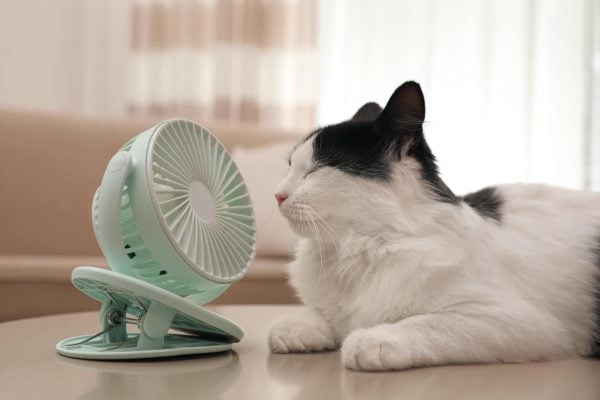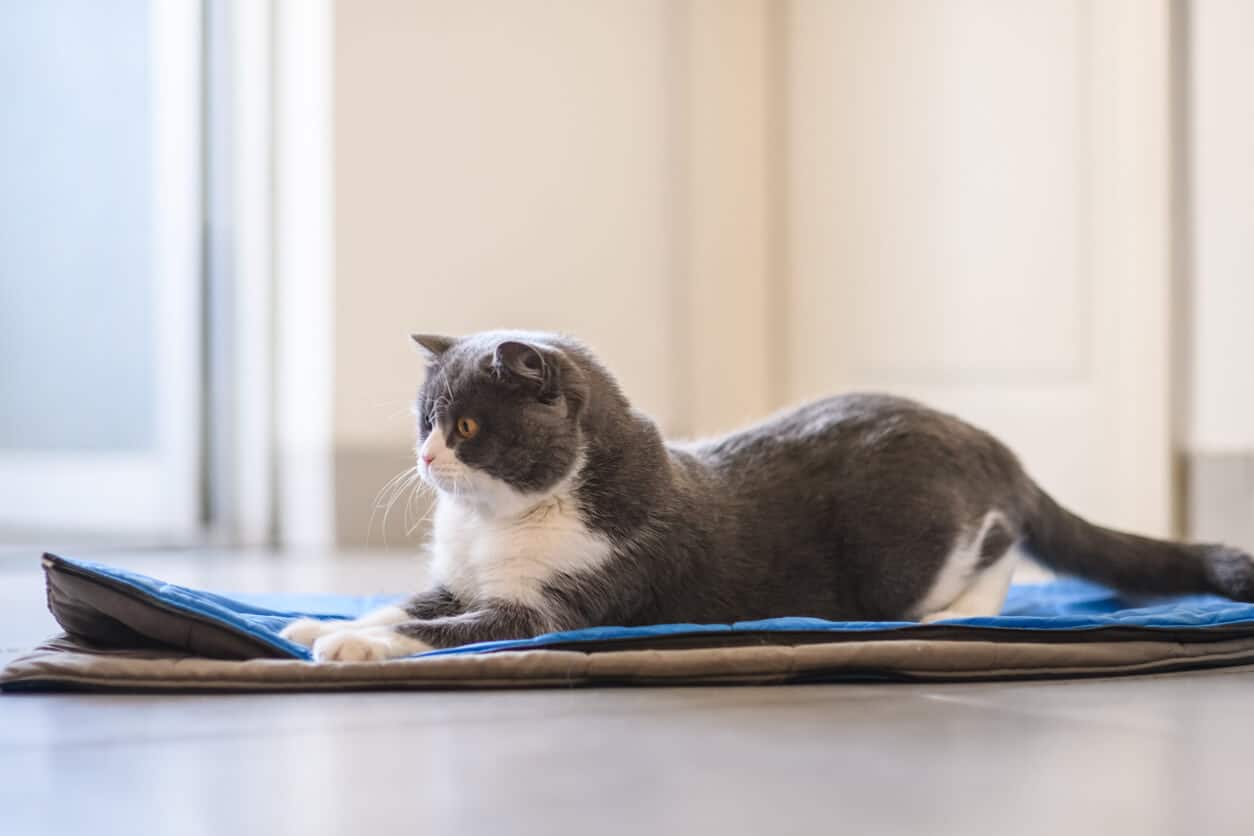- This post contains affiliate links. Read more here.
- Not a substitute for professional veterinary help.
Many cats love to sleep in a patch of sunlight on a summer day. But no matter how much they love to be warm, cats can still overheat and experience heat exhaustion or heatstroke.
Cats don’t sweat or pant to keep cool. Instead, they regulate their body temperature through grooming—the saliva they leave behind after licking themselves helps cool them off as it evaporates. But when it gets too hot, these efforts may not be enough.
Heatstroke, or hyperthermia, happens when a cat’s body temperature rises above their normal healthy range of 100.5°F-102.5°F to 105°F or higher. A temperature of 105°F is a life-threatening emergency.
“If a cat is experiencing heatstroke, acting quickly is critical,” says Dr. Sarah Vigil, Lead Veterinarian and Partner at CityVet Brushy Creek.
Here’s how to recognize the signs of overheating, plus what you can do to help your cat cool off.
When Is It Too Hot for Cats?
“When most people think of heatstroke, they probably imagine a dog trapped in a hot car. But heatstroke can also occur in cats,” says Dr. Liza Cahn, veterinary consultant for Embrace Pet Insurance.
Cats can develop heatstroke both indoors and outdoors, explains Dr. Kathryn Dench, veterinarian and owner of The Pets Kingdom. “It’s not only about the ambient temperature but also about humidity and ventilation.”
Indoor temperatures above 80°F (27°C) can pose a risk for cats, Dr. Dench says. Outdoors, temperatures of 90°F (32°C) and above are dangerous, especially in areas with direct sunlight and a lack of shade and water.
Risk factors
According to Drs. Dench, Cahn, and Vigil, some factors can increase a cat’s risk of heatstroke.
Cats with a higher risk of heatstroke include:
- Brachycephalic (flat-faced) breeds, like Persians
- Overweight and obese cats
- Long-haired cats
- Cats with certain medical conditions, like respiratory problems, epilepsy, and seizures
- Pregnant and nursing cats
- Senior cats or kittens
- Dark-haired cats
- Highly active cats
Subtle vs. Severe Signs Your Cat Is Overheating
“Heat stress is the mildest, earliest form of hyperthermia, or overheating,” Dr. Cahn says. “If it’s not addressed, it can quickly progress to heat exhaustion and heat stroke.”
Drs. Cahn and Vigil say early signs of overheating include:
- Restlessness and pacing
- Panting and open-mouth breathing
- Excessive grooming
- Unusual vocalizations
- Drooling
- Seeking shade or water
If your cat’s condition progresses to heatstroke, they may have more severe symptoms, including:
- Rapid, heavy panting and difficulty breathing
- Disorientation and poor coordination
- Pale gums or an unusual gum color, like purple or red
- Muscle tremors or shaking
- Vomiting
- Lethargy and weakness
- Loss of consciousness or collapse
- Seizures
Risks and Long-Term Effects of Heatstroke
Left untreated, heatstroke can cause widespread organ damage and death, Dr. Cahn says.
Heatstroke can do severe damage to a cat’s heart, liver, gastrointestinal tract, kidneys, and brain.
Even if your cat is otherwise healthy and has no history of medical problems, Dr. Dench says heatstroke may cause:
- Heart disease
- Weakened liver function or total liver failure
- Intestinal inflammation (colitis)
- GI bleeding and stomach ulcers
- Chronic kidney disease or kidney failure
- Seizures
- Abrupt behavioral and personality shifts, like sudden aggression
- Changes in mental state, like depression
- Permanent brain damage
How to Help an Overheating Cat Recover
If your cat has any signs of heatstroke, it’s essential to take immediate action by cooling them off while seeking urgent veterinary care, Dr. Cahn says.
Follow these steps:
- Move your cat: Start by immediately placing your cat in a cool room out of the sun. You can use fans to cool the room if you don’t have air conditioning.
- Offer water: Try to encourage your cat to drink, but don’t force them. Just leave cool, fresh water next to them so they can drink when they’re ready.
- Check your cat’s temperature: If you have a rectal thermometer and feel comfortable using it, Dr. Cahn says you can check your cat’s temperature. Any temperature above 102.5°F indicates overheating.
- Get them damp: Wet a washcloth or dish towel with lukewarm or cool water. Don’t soak the cloth. Gently pat your cat’s paws, belly, armpits, groin, and ears. Pay special attention to parts of the body with thinner hair, but avoid your cat’s face.
- Avoid dunking your cat: Don’t spray your cat with very cold water or dunk them in water. “Cooling cats down too quickly, like with ice cold water, can cause more harm, like organ damage or even death. It’s best to gradually cool them in a safe way,” Dr. Vigil says.
Is my cat getting better?
The steps above will often be enough to help cats in the early stages of overheating regain their normal body temperature. This may take 2-3 hours, according to Dr. Vigil.
You can tell your cat is improving if symptoms like drooling, panting, and vomiting stop. If their symptoms don’t improve or they have more severe symptoms, like seizures, muscle tremors, or fainting, they need urgent medical attention.
Even if your cat’s condition does improve, Drs. Cahn and Vigil still recommend taking your cat to the vet as soon as possible so they can do a full exam.
Overheating directly affects your cat’s organs, and complications from heat-induced organ damage may not show up right away. In some cases, several days can pass before delayed symptoms appear.
Getting prompt treatment from a vet will improve your cat’s chances of recovery.
When to ask a vet
Your cat needs urgent medical attention if you notice signs of overheating and:
- Don’t feel comfortable trying to cool your cat at home
- Your cat resists your efforts to cool them off
- Your cat’s symptoms get worse
It’s important to continue trying to cool your cat while taking them to the vet. Here’s how:
- Put a damp towel or cloth into your cat’s carrier. Wet the towel with lukewarm or cool water, not ice-cold water. Let your cat sit on the towel, but don’t wrap them in it.
- Make sure your cat carrier has enough ventilation, but keep it out of heat and sunlight.
- Turn on your car’s air conditioning to cool the car before you put your cat inside.
- You can roll down the windows for ventilation, but avoid opening them all the way, since this can create wind drafts.
- You can try calming pheromone sprays to ease your cat’s stress while you drive.
Heatstroke aftercare
After treatment for heatstroke, you’ll want to keep your cat in a cool, quiet place so they can recover fully, Dr. Dench says.
Pay close attention to your cat’s water intake to make sure they stay hydrated. You’ll also want to monitor their behavior for any signs they might be experiencing heat exhaustion again.
They may need ongoing supportive care for several weeks, Dr. Dench says. Your vet may also recommend tests to check their organ function.
How To Prevent Heatstroke
These tips from our experts can help prevent heat exhaustion and heatstroke in cats:
- Provide plenty of fresh water: The more water you offer your cat, the better! If you use bowls of still water, change them at least once a day. If you have an automatic water fountain, follow the manufacturer’s directions for cleaning it and changing the filter.
- Keep your home cool: Run your air conditioning or use fans on hot days. If you cat has a preference for specific rooms, take extra care to keep those rooms cool.
- Set up cooling mats: Cooling mats contain materials like gels, foams, or water. It might take some trial and error to find a cooling mat your cat prefers, and some cats may not like them at all. Try setting one up in your cat’s favorite spot, but make sure they also have plenty of shade and fresh water!
- Limit direct sunlight: If you have a sunny home, lower blinds and close curtains on the hottest days. Be careful not to accidentally trap your cat in a room with direct sunlight or other areas where heat rapidly builds up. Try setting up umbrellas, tarps, or insulated cat houses for outdoor cats.
- Brush and groom your cat: Routinely brushing your cat’s hair—or getting them professionally groomed—can help with heat dissipation, especially for long-haired breeds.
- Travel safely: If you’re traveling with your cat, never leave them alone in your car. The temperature inside your car can rise by 20 degrees in just 10 minutes! Instead, try a cat backpack or cat stroller. You could also try training your cat to walk on a leash ahead of time so you can take them with you whenever you leave the car.
How to help an outdoor cat
“If you’re caring for an outdoor cat, it’s crucial to provide them with shelter, water, and cooling options,” Dr. Vigil says.
Check on outdoor cats often on hot days. It’s easy to miss signs of heatstroke, like lethargy, collapse, or seizures, if you don’t know where the cat is. If it’s too hot outside, consider bringing your outdoor cat inside to a cooler spot.
You can offer outdoor cats cooler spaces by:
- Creating shade with umbrellas or tarps
- Setting up multiple tip-proof water bowls and drinking stations
- Setting up an insulated cat house
- Setting up a cooling box or cooling mats
- Placing ceramic tiles or stones in a shady spot




